Application for the Community Development Block Grant Program for Indian Tribes and Alaska Native Villages (ICDBG)
Application for the Community Development Block Grant Program for Indian Tribes and Alaska Native Villages (ICDBG)
HUD-96010 2010 ICDBG Logic Model.xls
Application for the Community Development Block Grant Program for Indian Tribes and Alaska Native Villages (ICDBG)
OMB: 2577-0191
⚠️ Notice: This form may be outdated. More recent filings and information on OMB 2577-0191 can be found here:
Document [xlsx]
Download: xlsx | pdf
Coversheet
Year1
Year2
Year3
Total
GoalsPriorities
Needs
Services
Outcomes
Tools
Reporting
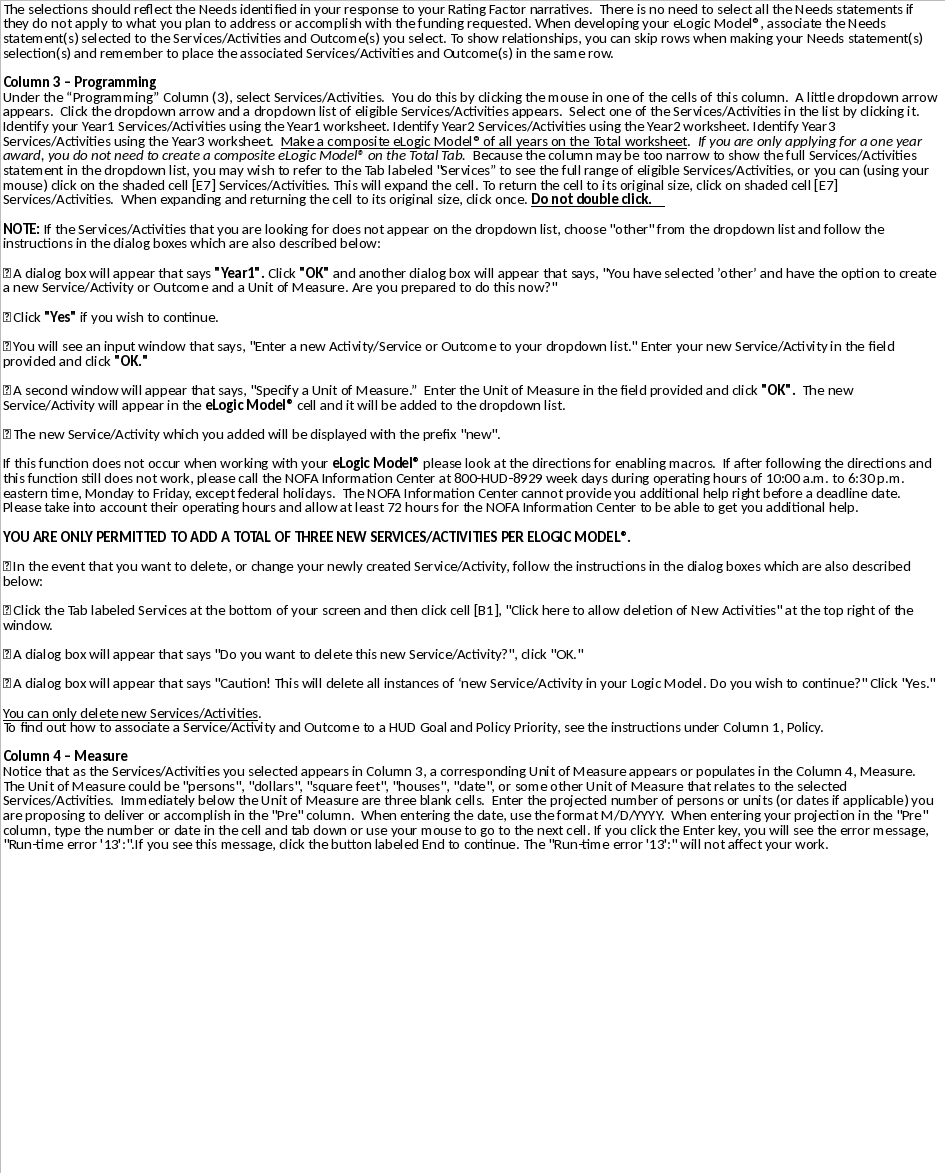



Overview
InstructionsCoversheet
Year1
Year2
Year3
Total
GoalsPriorities
Needs
Services
Outcomes
Tools
Reporting
Sheet 1: Instructions
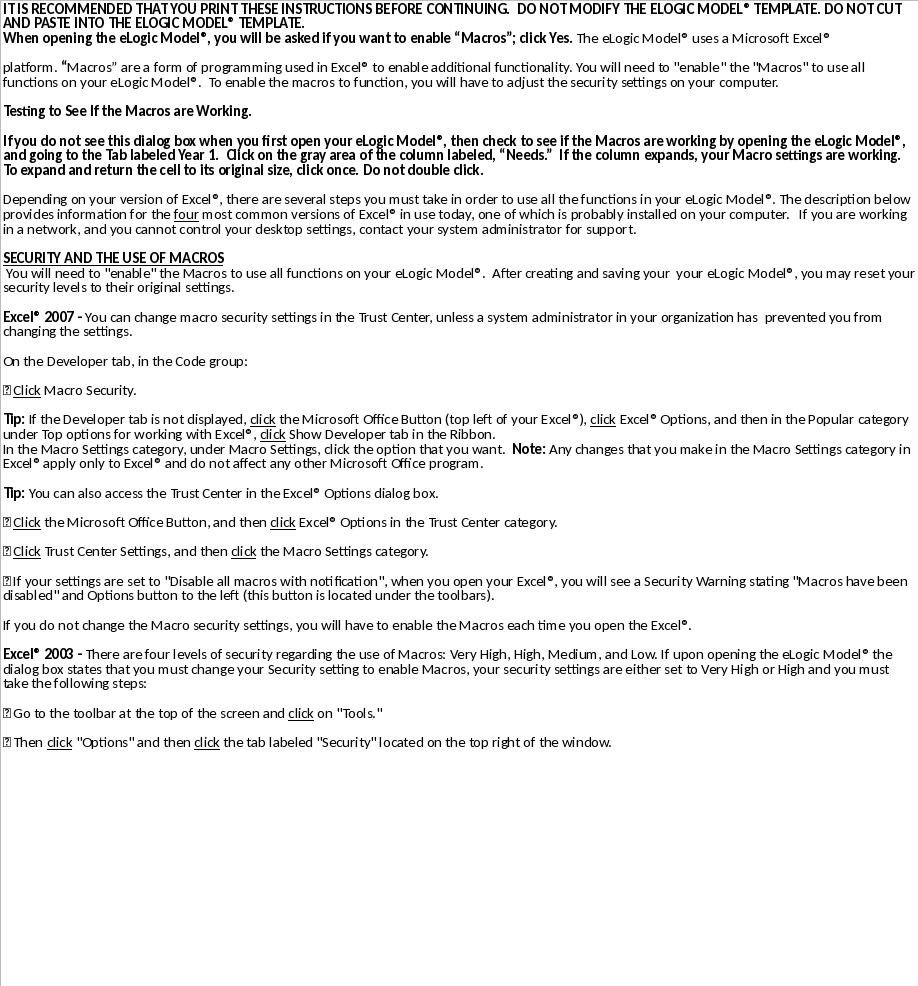
|
||||||||
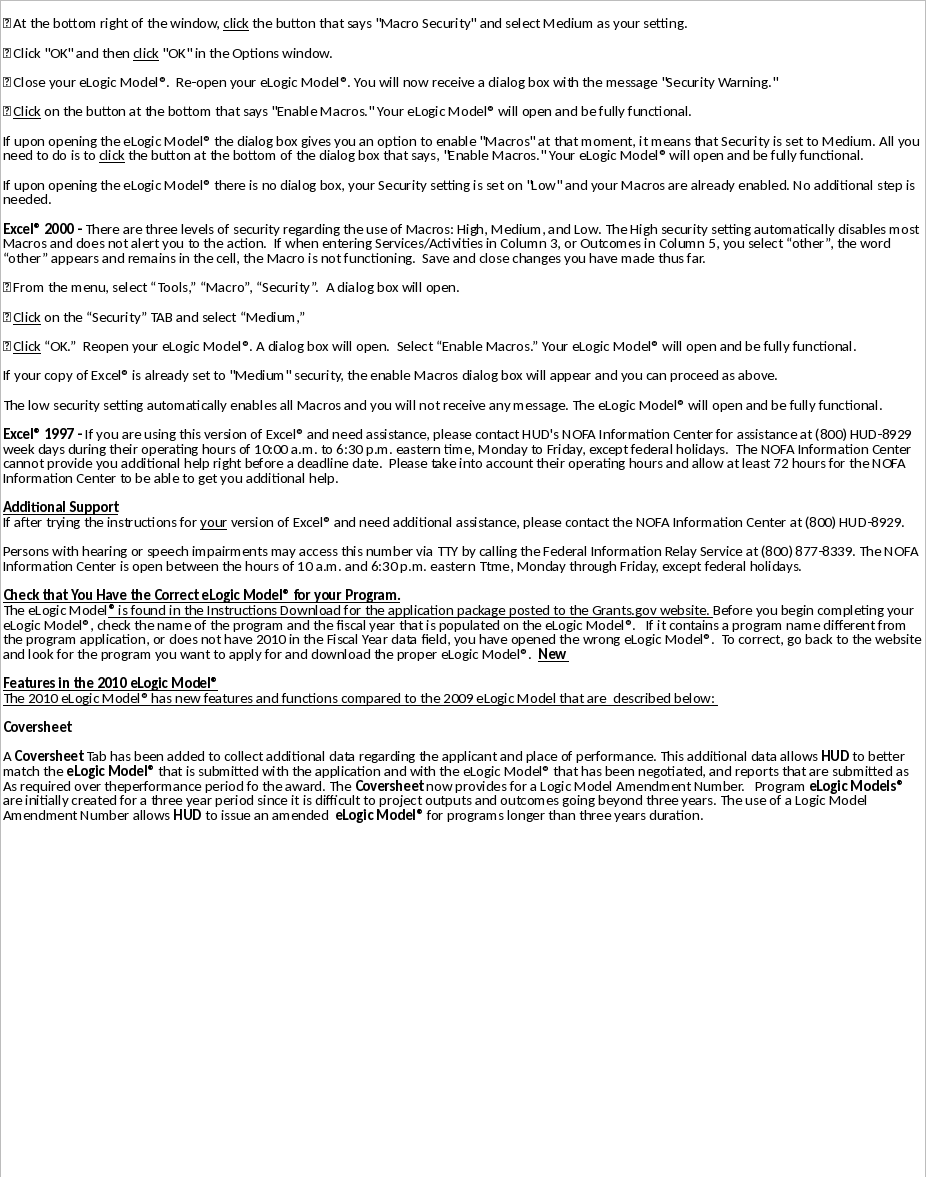
|
||||||||
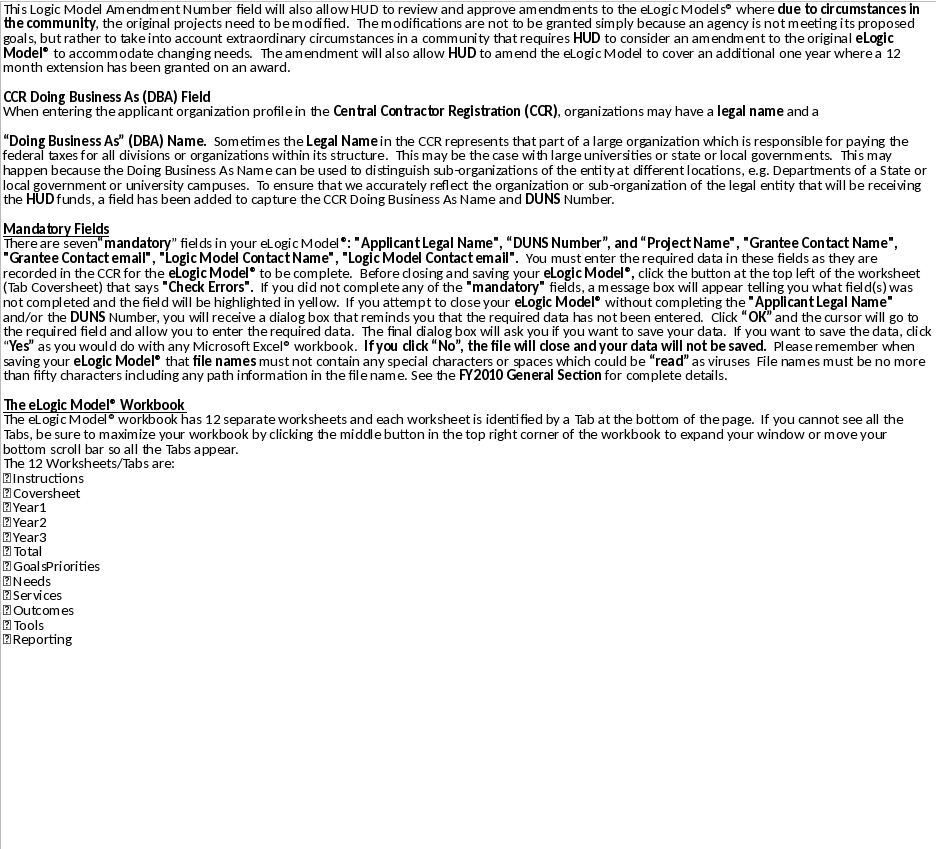
|
||||||||
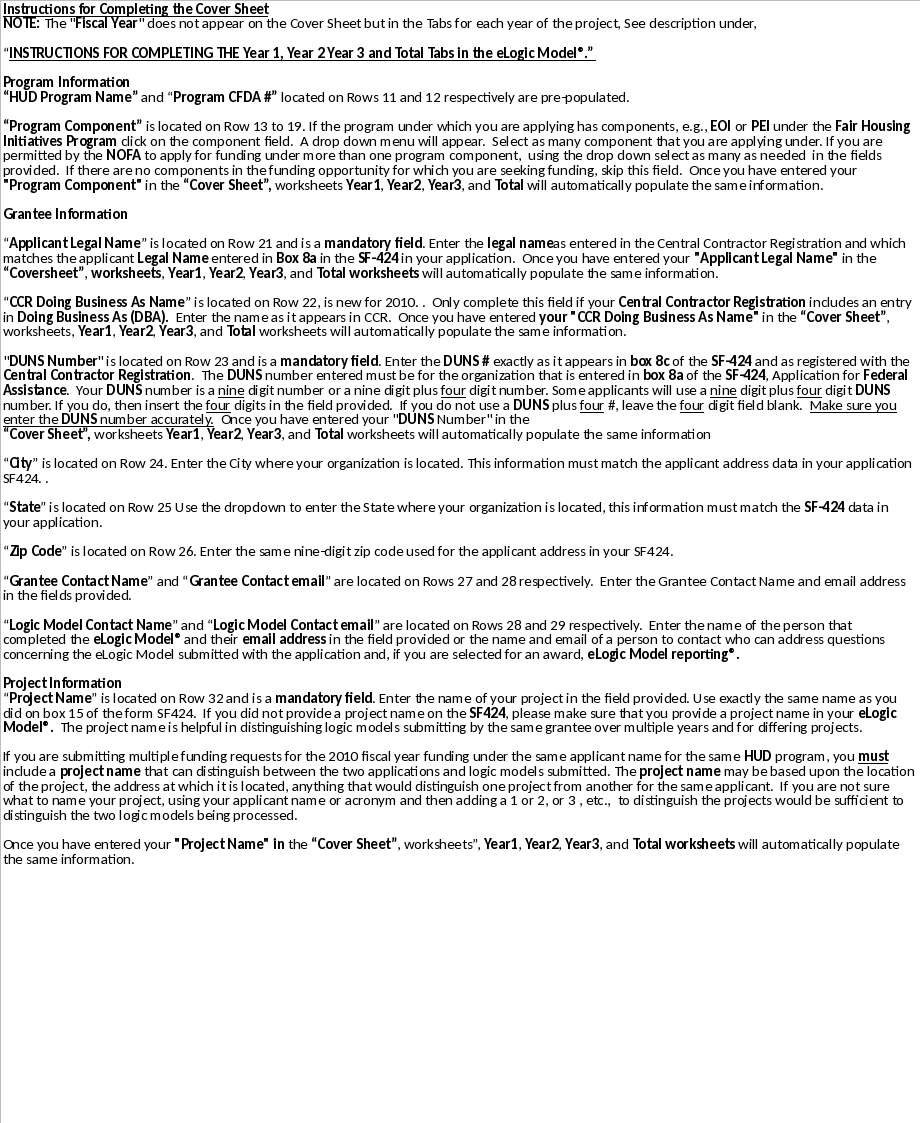
|
||||||||
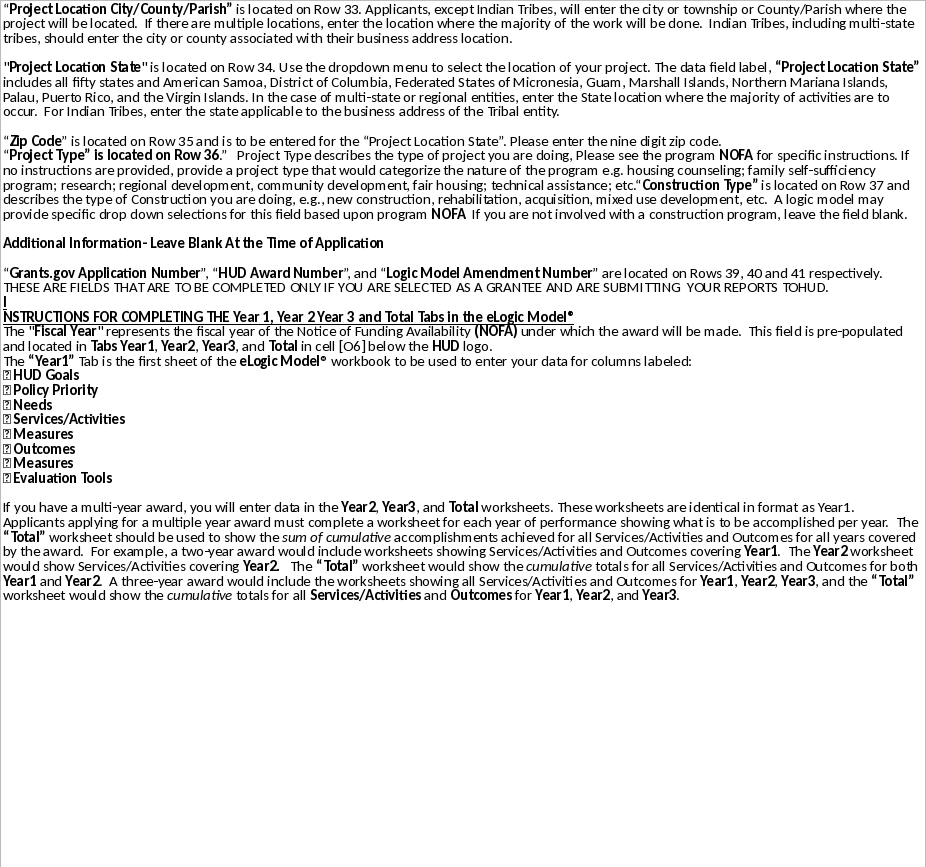
|
||||||||
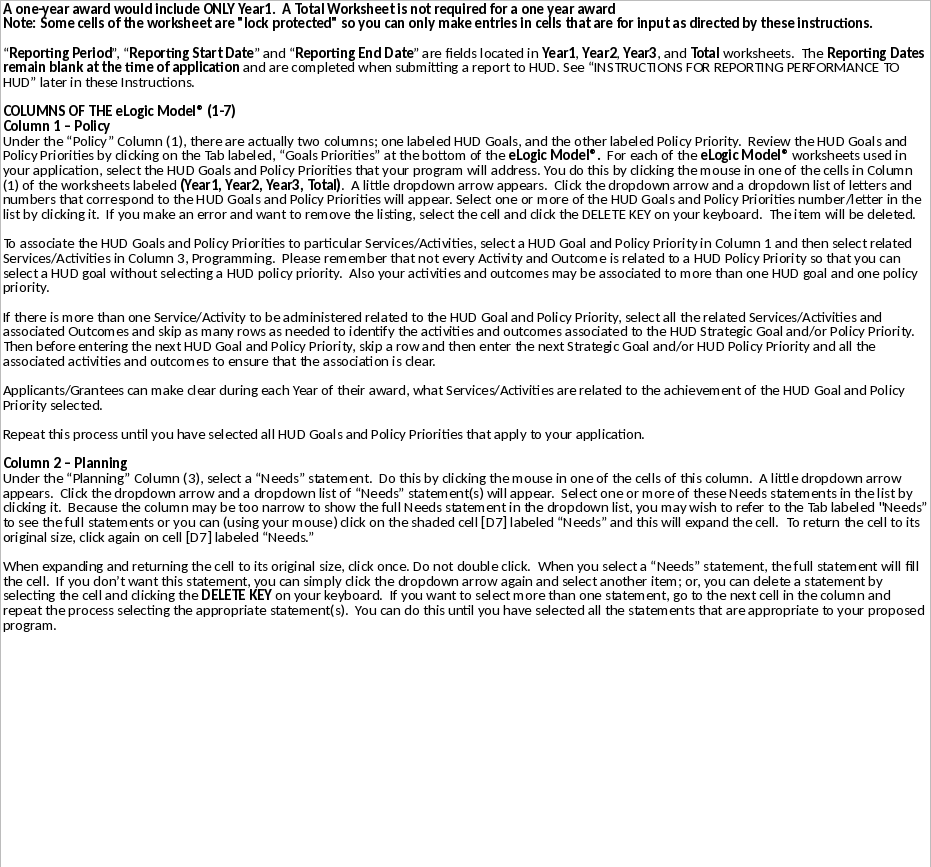
|
||||||||
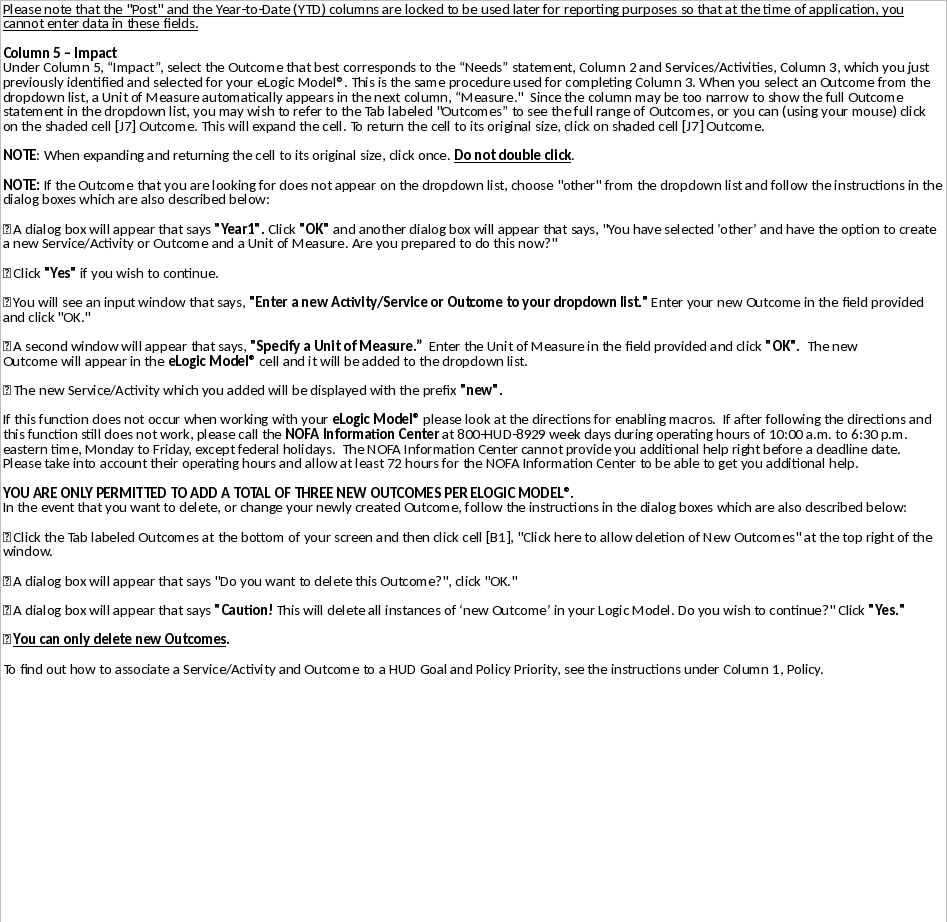
|
||||||||
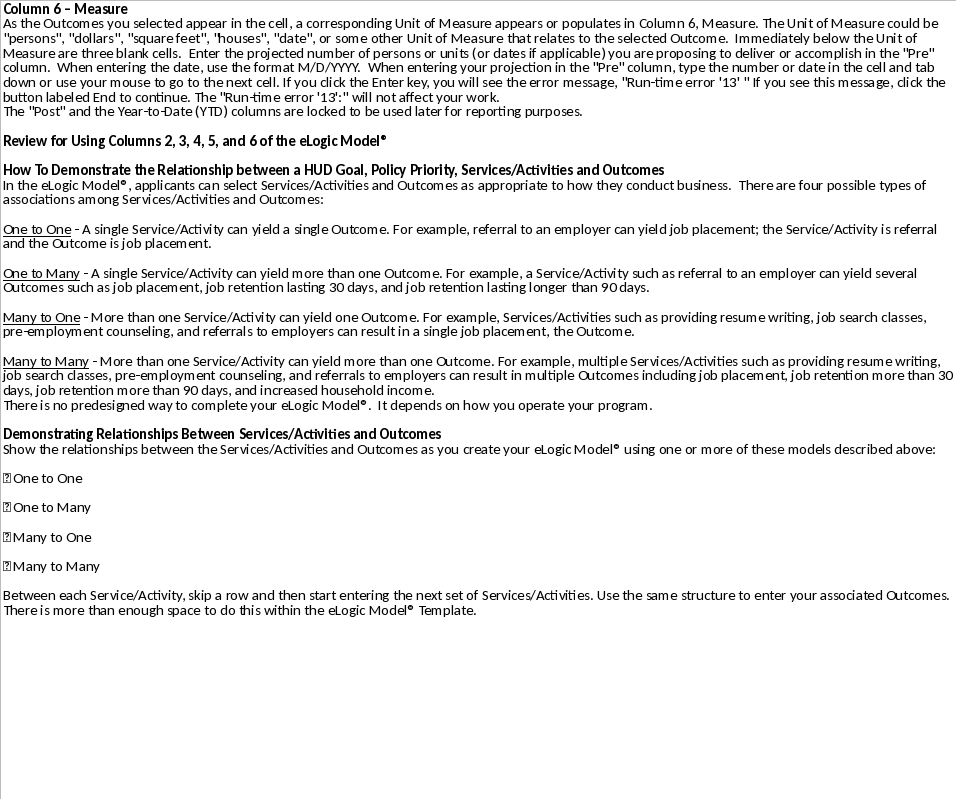
|
||||||||
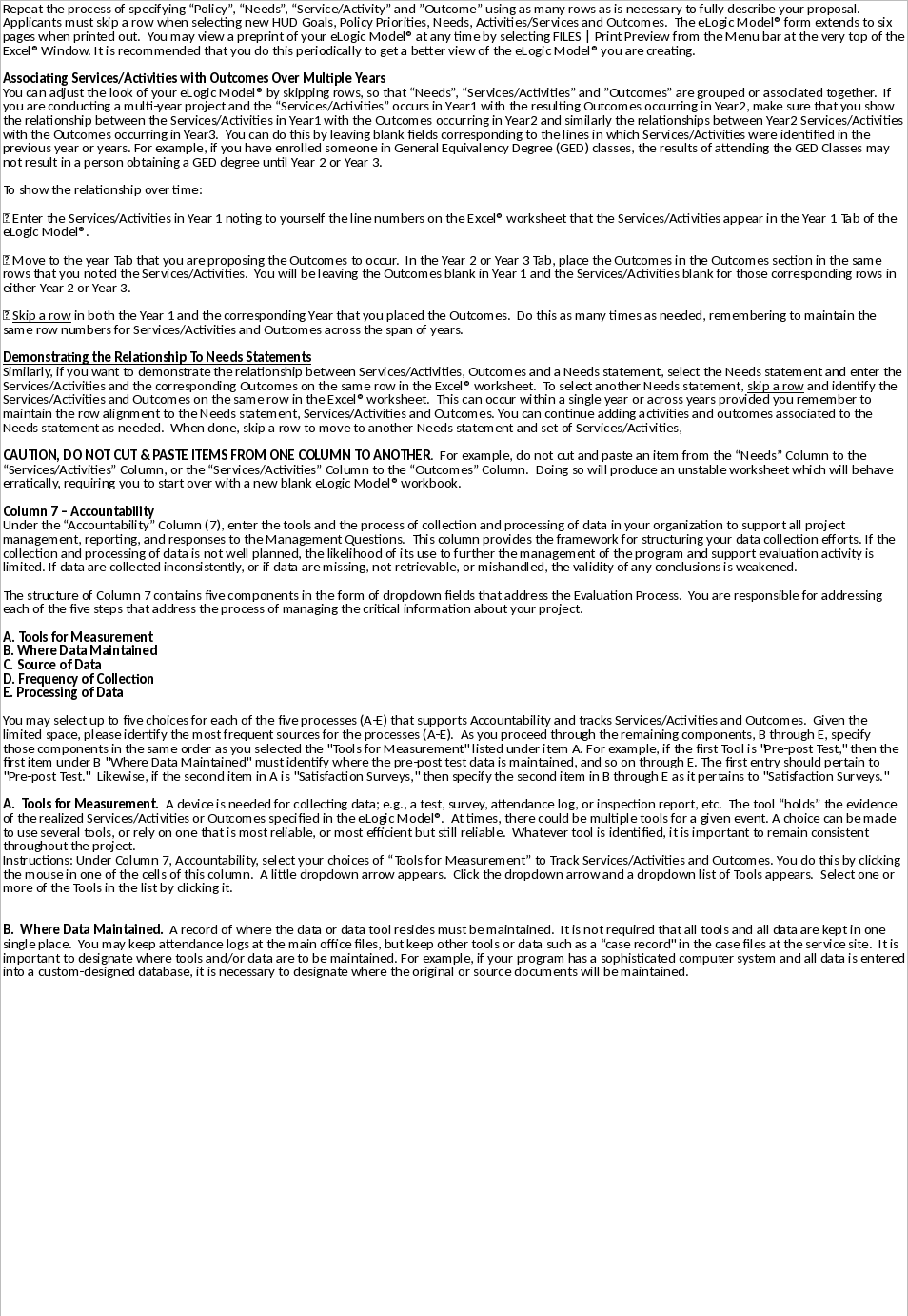
|
||||||||

|
||||||||
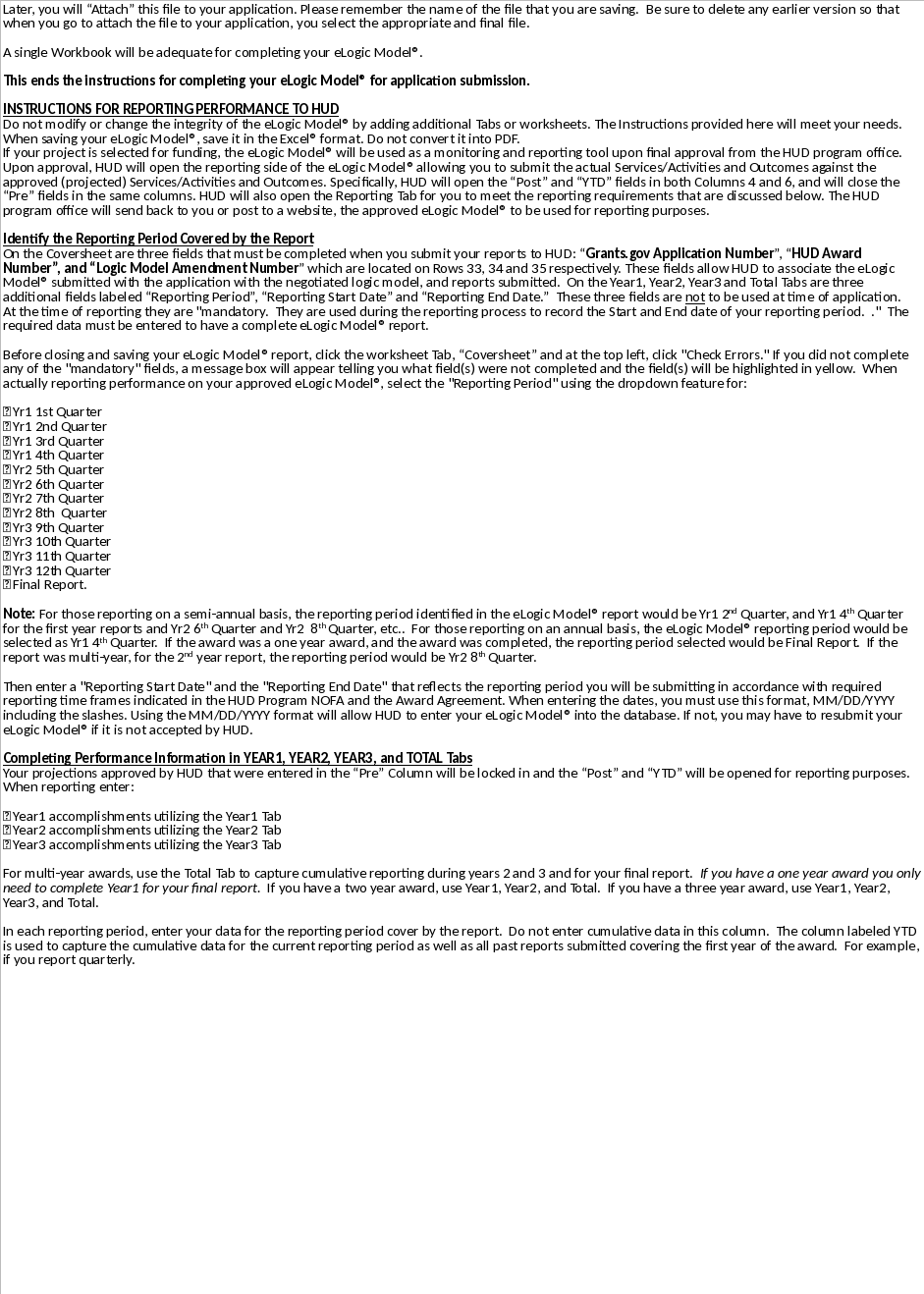
|
||||||||
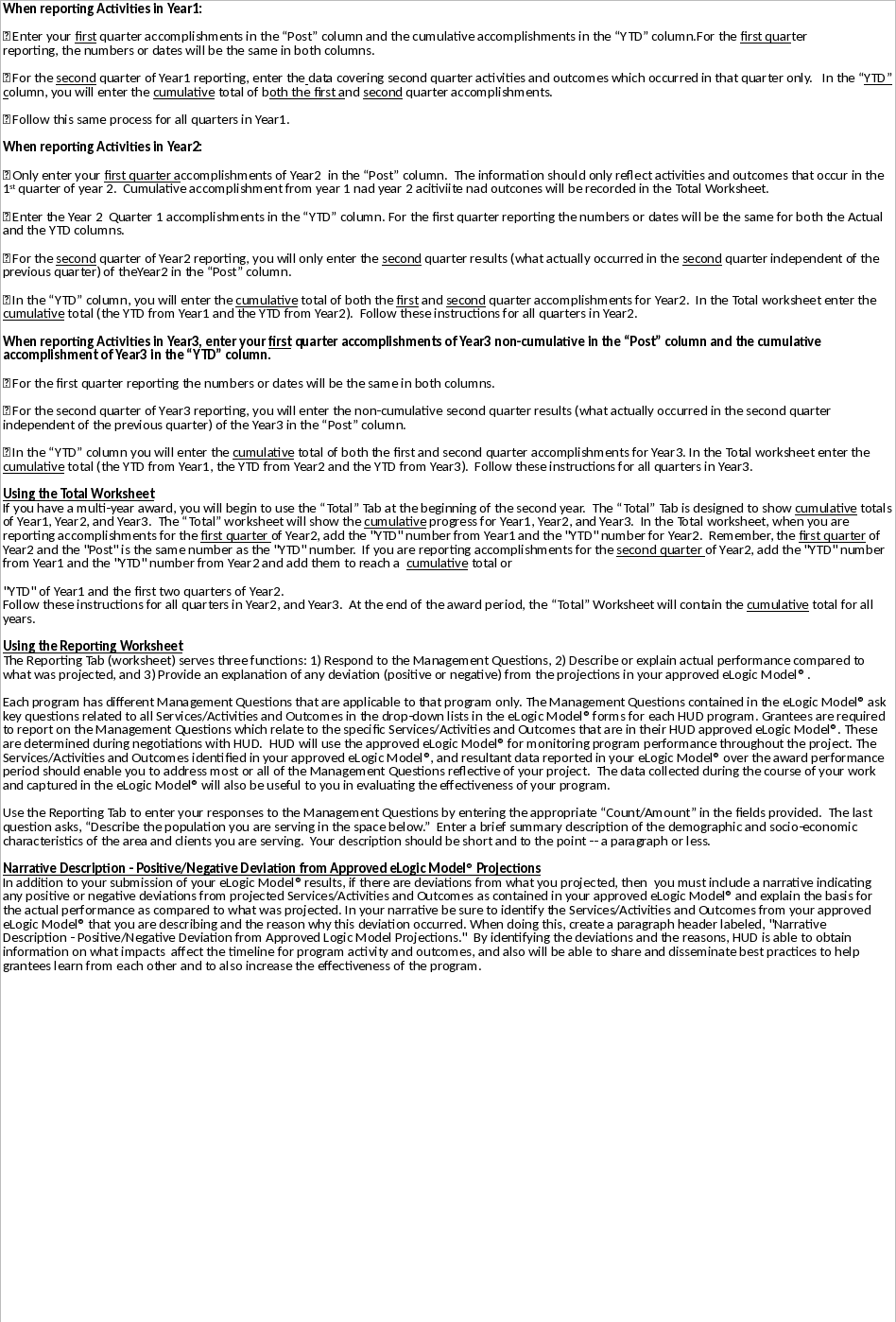
|
||||||||
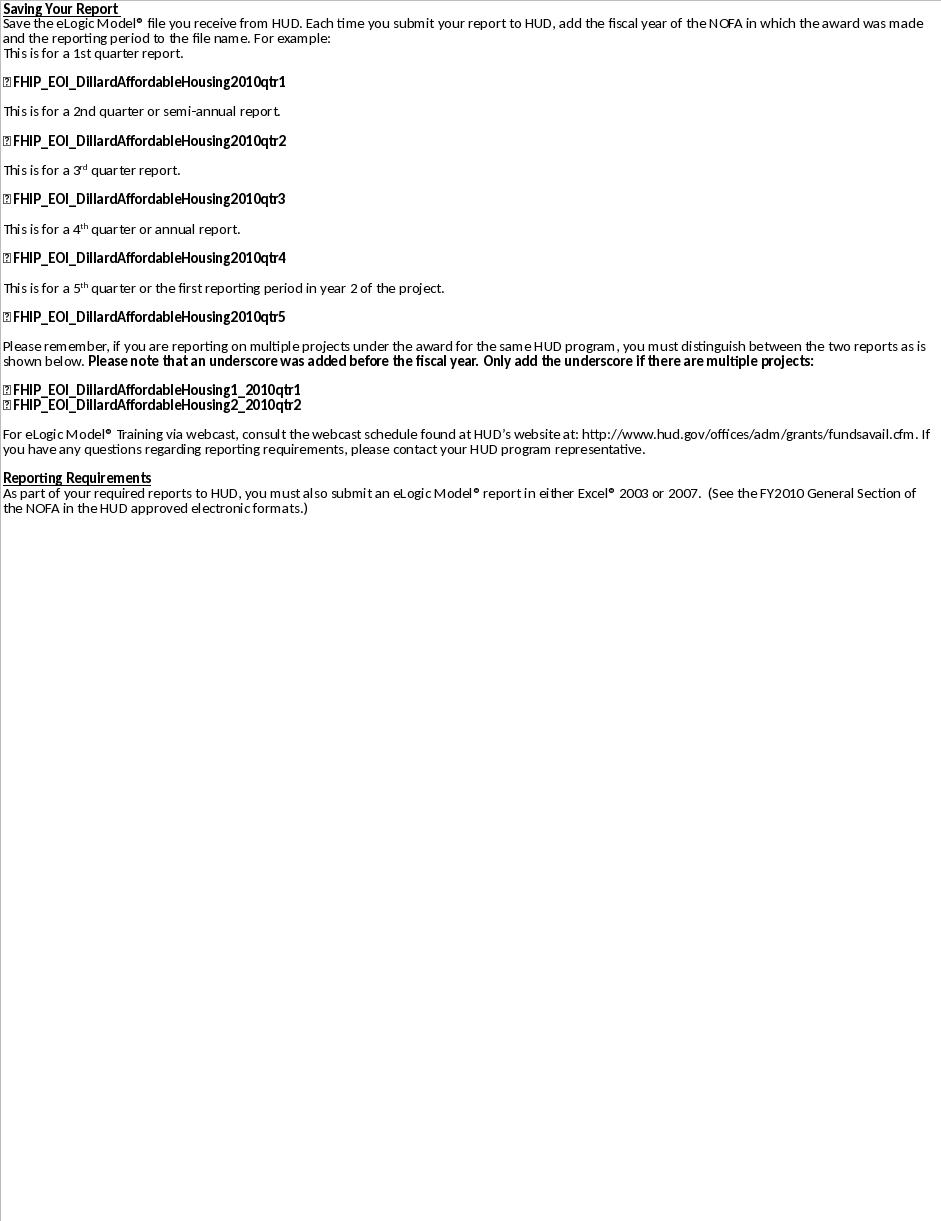
|
||||||||

Sheet 2: Coversheet

Sheet 3: Year1
| eLogic Model® | Year 1 | OMB Approval 2535-0114 exp. 2/28/2011 | ||||||||||||
| Applicant Legal Name | 0 | 
|
||||||||||||
| CCR Doing Business As Name | 0 | |||||||||||||
| HUD Program | ICDBG | Reporting Period | ||||||||||||
| Program Component | Reporting Start Date | DUNS No. | 0 | | 0 | |||||||||
| Project Name | 0 | Reporting End Date | 2010 | |||||||||||
| HUD Goals | Policy Priority | Needs | Services/Activities | Measures | Outcomes | Measures | Evaluation Tools | |||||||
| 1 | 2 | 3 | 4 | 5 | 6 | 7 | ||||||||
| Policy | Planning | Programming | Pre | Post | YTD | Impact | Pre | Post | YTD | Accountability | ||||
| #VALUE! | #VALUE! | |||||||||||||
| A. Tools for Measurement | ||||||||||||||
| #VALUE! | #VALUE! | |||||||||||||
| #VALUE! | #VALUE! | |||||||||||||
| #VALUE! | #VALUE! | |||||||||||||
| B. Where Data Maintained | ||||||||||||||
| #VALUE! | #VALUE! | |||||||||||||
| #VALUE! | #VALUE! | |||||||||||||
| #VALUE! | #VALUE! | |||||||||||||
| C. Source of Data | ||||||||||||||
| #VALUE! | #VALUE! | |||||||||||||
| #VALUE! | #VALUE! | |||||||||||||
| #VALUE! | #VALUE! | |||||||||||||
| D. Frequency of Collection | ||||||||||||||
| #VALUE! | #VALUE! | |||||||||||||
| #VALUE! | #VALUE! | |||||||||||||
| #VALUE! | #VALUE! | |||||||||||||
| E. Processing of Data | ||||||||||||||
| #VALUE! | #VALUE! | |||||||||||||
| #VALUE! | #VALUE! | |||||||||||||
| #VALUE! | #VALUE! | |||||||||||||
| #VALUE! | #VALUE! | |||||||||||||
| #VALUE! | #VALUE! | |||||||||||||
| #VALUE! | #VALUE! | |||||||||||||
| #VALUE! | #VALUE! | |||||||||||||
| #VALUE! | #VALUE! | |||||||||||||
| #VALUE! | #VALUE! | |||||||||||||
| #VALUE! | #VALUE! | |||||||||||||
| #VALUE! | #VALUE! | |||||||||||||
| #VALUE! | #VALUE! | |||||||||||||
| #VALUE! | #VALUE! | |||||||||||||
| #VALUE! | #VALUE! | |||||||||||||
| #VALUE! | #VALUE! | |||||||||||||
| #VALUE! | #VALUE! | |||||||||||||
| #VALUE! | #VALUE! | |||||||||||||
| #VALUE! | #VALUE! | |||||||||||||
| #VALUE! | #VALUE! | |||||||||||||
| #VALUE! | #VALUE! | |||||||||||||
| #VALUE! | #VALUE! | |||||||||||||
| #VALUE! | #VALUE! | |||||||||||||
| #VALUE! | #VALUE! | |||||||||||||
| #VALUE! | #VALUE! | |||||||||||||
| #VALUE! | #VALUE! | |||||||||||||
| #VALUE! | #VALUE! | |||||||||||||
| #VALUE! | #VALUE! | |||||||||||||
| #VALUE! | #VALUE! | |||||||||||||
| #VALUE! | #VALUE! | |||||||||||||
| #VALUE! | #VALUE! | |||||||||||||
| #VALUE! | #VALUE! | |||||||||||||
| #VALUE! | #VALUE! | |||||||||||||
| #VALUE! | #VALUE! | |||||||||||||
| #VALUE! | #VALUE! | |||||||||||||
| #VALUE! | #VALUE! | |||||||||||||
| #VALUE! | #VALUE! | |||||||||||||
| #VALUE! | #VALUE! | |||||||||||||
| #VALUE! | #VALUE! | Program Component | ||||||||||||
| 0 | ||||||||||||||
| #VALUE! | #VALUE! | 0 | ||||||||||||
| 0 | ||||||||||||||
| #VALUE! | #VALUE! | 0 | ||||||||||||
| 0 | ||||||||||||||
| #VALUE! | #VALUE! | 0 | ||||||||||||
| #VALUE! | #VALUE! | |||||||||||||
| #VALUE! | #VALUE! | |||||||||||||
| #VALUE! | #VALUE! | |||||||||||||
| #VALUE! | #VALUE! | |||||||||||||
| #VALUE! | #VALUE! | |||||||||||||
| #VALUE! | #VALUE! | |||||||||||||
| #VALUE! | #VALUE! | |||||||||||||
| #VALUE! | #VALUE! | |||||||||||||
| #VALUE! | #VALUE! | |||||||||||||
| #VALUE! | #VALUE! | |||||||||||||
| #VALUE! | #VALUE! | |||||||||||||
| #VALUE! | #VALUE! | |||||||||||||
| #VALUE! | #VALUE! | |||||||||||||
| #VALUE! | #VALUE! | |||||||||||||
| #VALUE! | #VALUE! | |||||||||||||
| #VALUE! | #VALUE! | |||||||||||||
| #VALUE! | #VALUE! | |||||||||||||
| #VALUE! | #VALUE! | |||||||||||||
| #VALUE! | #VALUE! | |||||||||||||
| #VALUE! | #VALUE! | |||||||||||||
| #VALUE! | #VALUE! | |||||||||||||
| #VALUE! | #VALUE! | |||||||||||||
| #VALUE! | #VALUE! | |||||||||||||
| #VALUE! | #VALUE! | |||||||||||||
| #VALUE! | #VALUE! | |||||||||||||
| #VALUE! | #VALUE! | |||||||||||||
| #VALUE! | #VALUE! | |||||||||||||
| #VALUE! | #VALUE! | |||||||||||||
| #VALUE! | #VALUE! | |||||||||||||
| #VALUE! | #VALUE! | |||||||||||||
| #VALUE! | #VALUE! | |||||||||||||
| #VALUE! | #VALUE! | |||||||||||||
| #VALUE! | #VALUE! | |||||||||||||
| #VALUE! | #VALUE! | |||||||||||||
| #VALUE! | #VALUE! | |||||||||||||
| #VALUE! | #VALUE! | |||||||||||||
| #VALUE! | #VALUE! | |||||||||||||
| #VALUE! | #VALUE! | |||||||||||||
| #VALUE! | #VALUE! | |||||||||||||
| #VALUE! | #VALUE! | |||||||||||||
| #VALUE! | #VALUE! | |||||||||||||
| #VALUE! | #VALUE! | |||||||||||||
| #VALUE! | #VALUE! | |||||||||||||
| #VALUE! | #VALUE! | |||||||||||||
| #VALUE! | #VALUE! | |||||||||||||
| #VALUE! | #VALUE! | |||||||||||||
| #VALUE! | #VALUE! | |||||||||||||
| #VALUE! | #VALUE! | |||||||||||||
| #VALUE! | #VALUE! | |||||||||||||
| #VALUE! | #VALUE! | |||||||||||||
| #VALUE! | #VALUE! | |||||||||||||
| #VALUE! | #VALUE! | |||||||||||||
| #VALUE! | #VALUE! | |||||||||||||
| #VALUE! | #VALUE! | |||||||||||||
Sheet 4: Year2
| eLogic Model® | Year 2 | OMB Approval 2535-0114 exp. 2/28/2011 | |||||||||||
| Applicant Legal Name | 0 | ||||||||||||
| CCR Doing Business As Name | 0 | ||||||||||||
| HUD Program | ICDBG | Reporting Period | |||||||||||
| Program Component | Reporting Start Date | DUNS No. | 0 | | 0 | ||||||||
| Project Name | 0 | Reporting End Date | 2010 | ||||||||||
| HUD Goals | Policy Priority | Needs | Services/Activities | Measures | Outcomes | Measures | Evaluation Tools | ||||||
| 1 | 2 | 3 | 4 | 5 | 6 | 7 | |||||||
| Policy | Planning | Programming | Pre | Post | YTD | Impact | Pre | Post | YTD | Accountability | |||
| #VALUE! | #VALUE! | ||||||||||||
| A. Tools for Measurement | |||||||||||||
| #VALUE! | #VALUE! | ||||||||||||
| #VALUE! | #VALUE! | ||||||||||||
| #VALUE! | #VALUE! | ||||||||||||
| B. Where Data Maintained | |||||||||||||
| #VALUE! | #VALUE! | ||||||||||||
| #VALUE! | #VALUE! | ||||||||||||
| #VALUE! | #VALUE! | ||||||||||||
| C. Source of Data | |||||||||||||
| #VALUE! | #VALUE! | ||||||||||||
| #VALUE! | #VALUE! | ||||||||||||
| #VALUE! | #VALUE! | ||||||||||||
| D. Frequency of Collection | |||||||||||||
| #VALUE! | #VALUE! | ||||||||||||
| #VALUE! | #VALUE! | ||||||||||||
| #VALUE! | #VALUE! | ||||||||||||
| E. Processing of Data | |||||||||||||
| #VALUE! | #VALUE! | ||||||||||||
| #VALUE! | #VALUE! | ||||||||||||
| #VALUE! | #VALUE! | ||||||||||||
| #VALUE! | #VALUE! | ||||||||||||
| #VALUE! | #VALUE! | ||||||||||||
| #VALUE! | #VALUE! | ||||||||||||
| #VALUE! | #VALUE! | ||||||||||||
| #VALUE! | #VALUE! | ||||||||||||
| #VALUE! | #VALUE! | ||||||||||||
| #VALUE! | #VALUE! | ||||||||||||
| #VALUE! | #VALUE! | ||||||||||||
| #VALUE! | #VALUE! | ||||||||||||
| #VALUE! | #VALUE! | ||||||||||||
| #VALUE! | #VALUE! | ||||||||||||
| #VALUE! | #VALUE! | ||||||||||||
| #VALUE! | #VALUE! | ||||||||||||
| #VALUE! | #VALUE! | ||||||||||||
| #VALUE! | #VALUE! | ||||||||||||
| #VALUE! | #VALUE! | ||||||||||||
| #VALUE! | #VALUE! | ||||||||||||
| #VALUE! | #VALUE! | ||||||||||||
| #VALUE! | #VALUE! | ||||||||||||
| #VALUE! | #VALUE! | ||||||||||||
| #VALUE! | #VALUE! | ||||||||||||
| #VALUE! | #VALUE! | ||||||||||||
| #VALUE! | #VALUE! | ||||||||||||
| #VALUE! | #VALUE! | ||||||||||||
| #VALUE! | #VALUE! | ||||||||||||
| #VALUE! | #VALUE! | ||||||||||||
| #VALUE! | #VALUE! | ||||||||||||
| #VALUE! | #VALUE! | ||||||||||||
| #VALUE! | #VALUE! | ||||||||||||
| #VALUE! | #VALUE! | ||||||||||||
| #VALUE! | #VALUE! | ||||||||||||
| #VALUE! | #VALUE! | ||||||||||||
| #VALUE! | #VALUE! | ||||||||||||
| #VALUE! | #VALUE! | ||||||||||||
| #VALUE! | #VALUE! | ||||||||||||
| 0 | |||||||||||||
| #VALUE! | #VALUE! | 0 | |||||||||||
| 0 | |||||||||||||
| #VALUE! | #VALUE! | 0 | |||||||||||
| 0 | |||||||||||||
| #VALUE! | #VALUE! | 0 | |||||||||||
| #VALUE! | #VALUE! | ||||||||||||
| #VALUE! | #VALUE! | ||||||||||||
| #VALUE! | #VALUE! | ||||||||||||
| #VALUE! | #VALUE! | ||||||||||||
| #VALUE! | #VALUE! | ||||||||||||
| #VALUE! | #VALUE! | ||||||||||||
| #VALUE! | #VALUE! | ||||||||||||
| #VALUE! | #VALUE! | ||||||||||||
| #VALUE! | #VALUE! | ||||||||||||
| #VALUE! | #VALUE! | ||||||||||||
| #VALUE! | #VALUE! | ||||||||||||
| #VALUE! | #VALUE! | ||||||||||||
| #VALUE! | #VALUE! | ||||||||||||
| #VALUE! | #VALUE! | ||||||||||||
| #VALUE! | #VALUE! | ||||||||||||
| #VALUE! | #VALUE! | ||||||||||||
| #VALUE! | #VALUE! | ||||||||||||
| #VALUE! | #VALUE! | ||||||||||||
| #VALUE! | #VALUE! | ||||||||||||
| #VALUE! | #VALUE! | ||||||||||||
| #VALUE! | #VALUE! | ||||||||||||
| #VALUE! | #VALUE! | ||||||||||||
| #VALUE! | #VALUE! | ||||||||||||
| #VALUE! | #VALUE! | ||||||||||||
| #VALUE! | #VALUE! | ||||||||||||
| #VALUE! | #VALUE! | ||||||||||||
| #VALUE! | #VALUE! | ||||||||||||
| #VALUE! | #VALUE! | ||||||||||||
| #VALUE! | #VALUE! | ||||||||||||
| #VALUE! | #VALUE! | ||||||||||||
| #VALUE! | #VALUE! | ||||||||||||
| #VALUE! | #VALUE! | ||||||||||||
| #VALUE! | #VALUE! | ||||||||||||
| #VALUE! | #VALUE! | ||||||||||||
| #VALUE! | #VALUE! | ||||||||||||
| #VALUE! | #VALUE! | ||||||||||||
| #VALUE! | #VALUE! | ||||||||||||
| #VALUE! | #VALUE! | ||||||||||||
| #VALUE! | #VALUE! | ||||||||||||
| #VALUE! | #VALUE! | ||||||||||||
| #VALUE! | #VALUE! | ||||||||||||
| #VALUE! | #VALUE! | ||||||||||||
| #VALUE! | #VALUE! | ||||||||||||
| #VALUE! | #VALUE! | ||||||||||||
| #VALUE! | #VALUE! | ||||||||||||
| #VALUE! | #VALUE! | ||||||||||||
| #VALUE! | #VALUE! | ||||||||||||
| #VALUE! | #VALUE! | ||||||||||||
| #VALUE! | #VALUE! | ||||||||||||
| #VALUE! | #VALUE! | ||||||||||||
| #VALUE! | #VALUE! | ||||||||||||
| #VALUE! | #VALUE! | ||||||||||||
| #VALUE! | #VALUE! | ||||||||||||
| #VALUE! | #VALUE! | ||||||||||||

Sheet 5: Year3
| eLogic Model® | Year 3 | OMB Approval 2535-0114 exp. 2/28/2011 | |||||||||||
| Applicant Legal Name | 0 | 
|
|||||||||||
| CCR Doing Business As Name | 0 | ||||||||||||
| HUD Program | ICDBG | Reporting Period | |||||||||||
| Program Component | Reporting Start Date | DUNS No. | 0 | | 0 | ||||||||
| Project Name | 0 | Reporting End Date | 2010 | ||||||||||
| HUD Goals | Policy Priority | Needs | Services/Activities | Measures | Outcomes | Measures | Evaluation Tools | ||||||
| 1 | 2 | 3 | 4 | 5 | 6 | 7 | |||||||
| Policy | Planning | Programming | Pre | Post | YTD | Impact | Pre | Post | YTD | Accountability | |||
| #VALUE! | #VALUE! | ||||||||||||
| A. Tools for Measurement | |||||||||||||
| #VALUE! | #VALUE! | ||||||||||||
| #VALUE! | #VALUE! | ||||||||||||
| #VALUE! | #VALUE! | ||||||||||||
| B. Where Data Maintained | |||||||||||||
| #VALUE! | #VALUE! | ||||||||||||
| #VALUE! | #VALUE! | ||||||||||||
| #VALUE! | #VALUE! | ||||||||||||
| C. Source of Data | |||||||||||||
| #VALUE! | #VALUE! | ||||||||||||
| #VALUE! | #VALUE! | ||||||||||||
| #VALUE! | #VALUE! | ||||||||||||
| D. Frequency of Collection | |||||||||||||
| #VALUE! | #VALUE! | ||||||||||||
| #VALUE! | #VALUE! | ||||||||||||
| #VALUE! | #VALUE! | ||||||||||||
| E. Processing of Data | |||||||||||||
| #VALUE! | #VALUE! | ||||||||||||
| #VALUE! | #VALUE! | ||||||||||||
| #VALUE! | #VALUE! | ||||||||||||
| #VALUE! | #VALUE! | ||||||||||||
| #VALUE! | #VALUE! | ||||||||||||
| #VALUE! | #VALUE! | ||||||||||||
| #VALUE! | #VALUE! | ||||||||||||
| #VALUE! | #VALUE! | ||||||||||||
| #VALUE! | #VALUE! | ||||||||||||
| #VALUE! | #VALUE! | ||||||||||||
| #VALUE! | #VALUE! | ||||||||||||
| #VALUE! | #VALUE! | ||||||||||||
| #VALUE! | #VALUE! | ||||||||||||
| #VALUE! | #VALUE! | ||||||||||||
| #VALUE! | #VALUE! | ||||||||||||
| #VALUE! | #VALUE! | ||||||||||||
| #VALUE! | #VALUE! | ||||||||||||
| #VALUE! | #VALUE! | ||||||||||||
| #VALUE! | #VALUE! | ||||||||||||
| #VALUE! | #VALUE! | ||||||||||||
| #VALUE! | #VALUE! | ||||||||||||
| #VALUE! | #VALUE! | ||||||||||||
| #VALUE! | #VALUE! | ||||||||||||
| #VALUE! | #VALUE! | ||||||||||||
| #VALUE! | #VALUE! | ||||||||||||
| #VALUE! | #VALUE! | ||||||||||||
| #VALUE! | #VALUE! | ||||||||||||
| #VALUE! | #VALUE! | ||||||||||||
| #VALUE! | #VALUE! | ||||||||||||
| #VALUE! | #VALUE! | ||||||||||||
| #VALUE! | #VALUE! | ||||||||||||
| #VALUE! | #VALUE! | ||||||||||||
| #VALUE! | #VALUE! | ||||||||||||
| #VALUE! | #VALUE! | ||||||||||||
| #VALUE! | #VALUE! | ||||||||||||
| #VALUE! | #VALUE! | ||||||||||||
| #VALUE! | #VALUE! | ||||||||||||
| #VALUE! | #VALUE! | ||||||||||||
| 0 | |||||||||||||
| #VALUE! | #VALUE! | 0 | |||||||||||
| 0 | |||||||||||||
| #VALUE! | #VALUE! | 0 | |||||||||||
| 0 | |||||||||||||
| #VALUE! | #VALUE! | 0 | |||||||||||
| #VALUE! | #VALUE! | ||||||||||||
| #VALUE! | #VALUE! | ||||||||||||
| #VALUE! | #VALUE! | ||||||||||||
| #VALUE! | #VALUE! | ||||||||||||
| #VALUE! | #VALUE! | ||||||||||||
| #VALUE! | #VALUE! | ||||||||||||
| #VALUE! | #VALUE! | ||||||||||||
| #VALUE! | #VALUE! | ||||||||||||
| #VALUE! | #VALUE! | ||||||||||||
| #VALUE! | #VALUE! | ||||||||||||
| #VALUE! | #VALUE! | ||||||||||||
| #VALUE! | #VALUE! | ||||||||||||
| #VALUE! | #VALUE! | ||||||||||||
| #VALUE! | #VALUE! | ||||||||||||
| #VALUE! | #VALUE! | ||||||||||||
| #VALUE! | #VALUE! | ||||||||||||
| #VALUE! | #VALUE! | ||||||||||||
| #VALUE! | #VALUE! | ||||||||||||
| #VALUE! | #VALUE! | ||||||||||||
| #VALUE! | #VALUE! | ||||||||||||
| #VALUE! | #VALUE! | ||||||||||||
| #VALUE! | #VALUE! | ||||||||||||
| #VALUE! | #VALUE! | ||||||||||||
| #VALUE! | #VALUE! | ||||||||||||
| #VALUE! | #VALUE! | ||||||||||||
| #VALUE! | #VALUE! | ||||||||||||
| #VALUE! | #VALUE! | ||||||||||||
| #VALUE! | #VALUE! | ||||||||||||
| #VALUE! | #VALUE! | ||||||||||||
| #VALUE! | #VALUE! | ||||||||||||
| #VALUE! | #VALUE! | ||||||||||||
| #VALUE! | #VALUE! | ||||||||||||
| #VALUE! | #VALUE! | ||||||||||||
| #VALUE! | #VALUE! | ||||||||||||
| #VALUE! | #VALUE! | ||||||||||||
| #VALUE! | #VALUE! | ||||||||||||
| #VALUE! | #VALUE! | ||||||||||||
| #VALUE! | #VALUE! | ||||||||||||
| #VALUE! | #VALUE! | ||||||||||||
| #VALUE! | #VALUE! | ||||||||||||
| #VALUE! | #VALUE! | ||||||||||||
| #VALUE! | #VALUE! | ||||||||||||
| #VALUE! | #VALUE! | ||||||||||||
| #VALUE! | #VALUE! | ||||||||||||
| #VALUE! | #VALUE! | ||||||||||||
| #VALUE! | #VALUE! | ||||||||||||
| #VALUE! | #VALUE! | ||||||||||||
| #VALUE! | #VALUE! | ||||||||||||
| #VALUE! | #VALUE! | ||||||||||||
| #VALUE! | #VALUE! | ||||||||||||
| #VALUE! | #VALUE! | ||||||||||||
| #VALUE! | #VALUE! | ||||||||||||
| #VALUE! | #VALUE! | ||||||||||||
| #VALUE! | #VALUE! | ||||||||||||
Sheet 6: Total
| eLogic Model® | Total | OMB Approval 2535-0114 exp. 2/28/2011 | |||||||||||
| Applicant Legal Name | 0 | 
|
|||||||||||
| CCR Doing Business As Name | 0 | ||||||||||||
| HUD Program | ICDBG | Reporting Period | |||||||||||
| Program Component | Reporting Start Date | DUNS No. | 0 | | 0 | ||||||||
| Project Name | 0 | Reporting End Date | 2010 | ||||||||||
| HUD Goals | Policy Priority | Needs | Services/Activities | Measures | Outcomes | Measures | Evaluation Tools | ||||||
| 1 | 2 | 3 | 4 | 5 | 6 | 7 | |||||||
| Policy | Planning | Programming | Pre | Post | YTD | Impact | Pre | Post | YTD | Accountability | |||
| #VALUE! | #VALUE! | ||||||||||||
| A. Tools for Measurement | |||||||||||||
| #VALUE! | #VALUE! | ||||||||||||
| #VALUE! | #VALUE! | ||||||||||||
| #VALUE! | #VALUE! | ||||||||||||
| B. Where Data Maintained | |||||||||||||
| #VALUE! | #VALUE! | ||||||||||||
| #VALUE! | #VALUE! | ||||||||||||
| #VALUE! | #VALUE! | ||||||||||||
| C. Source of Data | |||||||||||||
| #VALUE! | #VALUE! | ||||||||||||
| #VALUE! | #VALUE! | ||||||||||||
| #VALUE! | #VALUE! | ||||||||||||
| D. Frequency of Collection | |||||||||||||
| #VALUE! | #VALUE! | ||||||||||||
| #VALUE! | #VALUE! | ||||||||||||
| #VALUE! | #VALUE! | ||||||||||||
| E. Processing of Data | |||||||||||||
| #VALUE! | #VALUE! | ||||||||||||
| #VALUE! | #VALUE! | ||||||||||||
| #VALUE! | #VALUE! | ||||||||||||
| #VALUE! | #VALUE! | ||||||||||||
| #VALUE! | #VALUE! | ||||||||||||
| #VALUE! | #VALUE! | ||||||||||||
| #VALUE! | #VALUE! | ||||||||||||
| #VALUE! | #VALUE! | ||||||||||||
| #VALUE! | #VALUE! | ||||||||||||
| #VALUE! | #VALUE! | ||||||||||||
| #VALUE! | #VALUE! | ||||||||||||
| #VALUE! | #VALUE! | ||||||||||||
| #VALUE! | #VALUE! | ||||||||||||
| #VALUE! | #VALUE! | ||||||||||||
| #VALUE! | #VALUE! | ||||||||||||
| #VALUE! | #VALUE! | ||||||||||||
| #VALUE! | #VALUE! | ||||||||||||
| #VALUE! | #VALUE! | ||||||||||||
| #VALUE! | #VALUE! | ||||||||||||
| #VALUE! | #VALUE! | ||||||||||||
| #VALUE! | #VALUE! | ||||||||||||
| #VALUE! | #VALUE! | ||||||||||||
| #VALUE! | #VALUE! | ||||||||||||
| #VALUE! | #VALUE! | ||||||||||||
| #VALUE! | #VALUE! | ||||||||||||
| #VALUE! | #VALUE! | ||||||||||||
| #VALUE! | #VALUE! | ||||||||||||
| #VALUE! | #VALUE! | ||||||||||||
| #VALUE! | #VALUE! | ||||||||||||
| #VALUE! | #VALUE! | ||||||||||||
| #VALUE! | #VALUE! | ||||||||||||
| #VALUE! | #VALUE! | ||||||||||||
| #VALUE! | #VALUE! | ||||||||||||
| #VALUE! | #VALUE! | ||||||||||||
| #VALUE! | #VALUE! | ||||||||||||
| #VALUE! | #VALUE! | ||||||||||||
| #VALUE! | #VALUE! | ||||||||||||
| #VALUE! | #VALUE! | ||||||||||||
| 0 | |||||||||||||
| #VALUE! | #VALUE! | 0 | |||||||||||
| 0 | |||||||||||||
| #VALUE! | #VALUE! | 0 | |||||||||||
| 0 | |||||||||||||
| #VALUE! | #VALUE! | 0 | |||||||||||
| #VALUE! | #VALUE! | ||||||||||||
| #VALUE! | #VALUE! | ||||||||||||
| #VALUE! | #VALUE! | ||||||||||||
| #VALUE! | #VALUE! | ||||||||||||
| #VALUE! | #VALUE! | ||||||||||||
| #VALUE! | #VALUE! | ||||||||||||
| #VALUE! | #VALUE! | ||||||||||||
| #VALUE! | #VALUE! | ||||||||||||
| #VALUE! | #VALUE! | ||||||||||||
| #VALUE! | #VALUE! | ||||||||||||
| #VALUE! | #VALUE! | ||||||||||||
| #VALUE! | #VALUE! | ||||||||||||
| #VALUE! | #VALUE! | ||||||||||||
| #VALUE! | #VALUE! | ||||||||||||
| #VALUE! | #VALUE! | ||||||||||||
| #VALUE! | #VALUE! | ||||||||||||
| #VALUE! | #VALUE! | ||||||||||||
| #VALUE! | #VALUE! | ||||||||||||
| #VALUE! | #VALUE! | ||||||||||||
| #VALUE! | #VALUE! | ||||||||||||
| #VALUE! | #VALUE! | ||||||||||||
| #VALUE! | #VALUE! | ||||||||||||
| #VALUE! | #VALUE! | ||||||||||||
| #VALUE! | #VALUE! | ||||||||||||
| #VALUE! | #VALUE! | ||||||||||||
| #VALUE! | #VALUE! | ||||||||||||
| #VALUE! | #VALUE! | ||||||||||||
| #VALUE! | #VALUE! | ||||||||||||
| #VALUE! | #VALUE! | ||||||||||||
| #VALUE! | #VALUE! | ||||||||||||
| #VALUE! | #VALUE! | ||||||||||||
| #VALUE! | #VALUE! | ||||||||||||
| #VALUE! | #VALUE! | ||||||||||||
| #VALUE! | #VALUE! | ||||||||||||
| #VALUE! | #VALUE! | ||||||||||||
| #VALUE! | #VALUE! | ||||||||||||
| #VALUE! | #VALUE! | ||||||||||||
| #VALUE! | #VALUE! | ||||||||||||
| #VALUE! | #VALUE! | ||||||||||||
| #VALUE! | #VALUE! | ||||||||||||
| #VALUE! | #VALUE! | ||||||||||||
| #VALUE! | #VALUE! | ||||||||||||
| #VALUE! | #VALUE! | ||||||||||||
| #VALUE! | #VALUE! | ||||||||||||
| #VALUE! | #VALUE! | ||||||||||||
| #VALUE! | #VALUE! | ||||||||||||
| #VALUE! | #VALUE! | ||||||||||||
| #VALUE! | #VALUE! | ||||||||||||
| #VALUE! | #VALUE! | ||||||||||||
| #VALUE! | #VALUE! | ||||||||||||
| #VALUE! | #VALUE! | ||||||||||||
| #VALUE! | #VALUE! | ||||||||||||
| #VALUE! | #VALUE! | ||||||||||||
| #VALUE! | #VALUE! | ||||||||||||
Sheet 7: GoalsPriorities
| HUD Goals | HUD Priorities | |||
| 1A | Strengthen the Nation’s Housing Market to Bolster the Economy and Protect Consumers (1A) Stem the foreclosure crisis. | 1a | Job Creation/Employment (1a) Improving access to job opportunities through information sharing, coordination with federal, state, and local entities, and other means. | |
| 1B | Strengthen the Nation’s Housing Market to Bolster the Economy and Protect Consumer (1B) Protect and educate consumers when they buy, refinance or rent a home. | 1b | Job Creation/Employment (1b) Increasing access to job training, career services, and work, supports through coordination with federal, state, and local entities. | |
| 1C | Strengthen the Nation’s Housing Market to Bolster the Economy and Protect Consumers (1C) Create financially sustainable homeownership opportunities. | 1c | Job Creation/Employment (1c) Expanding economic and job creation opportunities for low-income residents and creating better transportation access to those jobs and other economic opportunities by partnering with federal and nonprofit agencies, private industry, and planning and economic development organizations and by leveraging federal and private resources. | |
| 1D | Strengthen the Nation’s Housing Market to Bolster the Economy and Protect Consumers (1D) Establish an accountable and sustainable housing finance system. | 2a | Sustainability (2a) Promote and preserve community assets including small businesses, fresh food markets, parks, hospitals, and quality schools by incentivizing comprehensive and inclusive local economic development planning. | |
| 2A | Meet the Need for Quality Affordable Rental Homes (2A) End homelessness and substantially reduce the number of families and individuals with severe housing needs. | 2b | Sustainability (2b) Give consumers more information about the true cost of living by incorporating both housing and transportation costs into measures of affordability. | |
| 2B | Meet the Need for Quality Affordable Rental Homes (2B) Expand the supply of affordable rental homes where most needed. | 2c | Sustainability (2c) Improve residents’ health and safety, particularly that of children and other vulnerable populations, by promoting green and healthy design, construction, rehabilitation, and maintenance of housing and communities. | |
| 2C | Meet the Need for Quality Affordable Rental Homes (2C) Preserve the affordability and improve the quality of federally assisted and private unassisted affordable rental homes. | 2d | Sustainability (2d) Support and promote an energy-efficient, green, and healthy housing market by retrofitting existing housing, supporting energy-efficient new construction, improving home energy labeling, and promoting financing products that reduce the carbon footprint of non-HUD-supported residential buildings. | |
| 2D | Meet the Need for Quality Affordable Rental Homes (2D) Expand families' choices of affordable rental homes located in a broad range of communities. | 2e | Sustainability (2e) Reduce energy consumption and incorporate green building practices in the design and operation of HUD-supported affordable housing. | |
| 3A | Utilize Housing as a Platform for Improving Quality of Life (3A) Utilize HUD assistance to improve educational outcomes and early learning and development. | 2f | Sustainability (2f) Promote coordinated planning, integrating federal resources, and targeting technical assistance at the local, state, and regional levels for sustainable housing and communities. | |
| 3B | Utilize Housing as a Platform for Improving Quality of Life (3B) Utilize HUD assistance to improve health outcomes. | 2g | Sustainability (2g) Promote the design and construction of buildings and communities that are accessible and visitable by people with disabilities. | |
| 3C | Utilize Housing as a Platform for Improving Quality of Life (3C) Utilize HUD assistance to increase economic security and self-sufficiency. | 2h | Sustainability (2h) Promote the use of climate-resilient and disaster-resistant building design, construction and siting. | |
| 3D | Utilize Housing as a Platform for Improving Quality of Life (3D) Utilize HUD assistance to improve housing stability through supportive services for vulnerable populations including the elderly, people with disabilities, homeless people, and those individuals and families at risk of becoming homeless. | 2i | Sustainability (2i) Encourage metropolitan and regional focus in planning and community development. | |
| 3E | Utilize Housing as a Platform for Improving Quality of Life (3E) Utilize HUD assistance to improve public safety. | 3a | Affirmatively Furthering Fair Housing (3a) Regional coordination of affirmatively furthering fair housing plans, including such activities as developing regional analyses of impediments. | |
| 4A | Build Inclusive and Sustainable Communities Free from Discrimination (4A) Catalyze economic development and job creation, while enhancing and preserving community assets. | 3b | Affirmatively Furthering Fair Housing (3b) Regional strategies to reduce racially segregated living patterns and other effects of formely de jure segregated public or assisted housing in metropolitan areas with a year 2000 dissimilarity index of 70 or higher and where the minority population is at least 20,000 or 3 percent of the total population in the Core Based Statistical Area (CBSA), whichever is greater. | |
| 4B | Build Inclusive and Sustainable Communities Free from Discrimination (4B) Promote energy efficient buildings and location efficient communities that are healthy, affordable and diverse. | 3c | Affirmatively Furthering Fair Housing (3c) Decreasing the concentration of poverty and racial segregation in neighborhoods and communities through strategic targeting of resources. | |
| 4C | Build Inclusive and Sustainable Communities Free from Discrimination (4C) Ensure open, diverse, and equitable communities. | 3d | Affirmatively Furthering Fair Housing (3d) Promoting visitability for persons with disabilities in single-family housing. | |
| 4D | Build Inclusive and Sustainable Communities Free from Discrimination (4D) Facilitate disaster preparedness, recovery and resiliency. | 4a | Capacity Building and Knowledge Sharing (4a) Develop, target and deliver technical assistance for increasing affordability in areas experiencing increased rental costs due to development. | |
| 4E | Build Inclusive and Sustainable Communities Free from Discrimination (4E) Build the capacity of local, state and regional public and private organizations. | 4b | Capacity Building and Knowledge Sharing (4b) Strengthen the capacity of state and local partners, including governments and nonprofit organizations, to implement HUD programs, participate in decision making and planning processes, and coordinate on cross-programmatic, place-based approaches through grantmaking and technical assistance. | |
| 5A | Transform the Way HUD Does Business (5A) Build Capacity: Create a flexible and high performing learning organization with a motivated, skilled workforce. | 4c | Capacity Building and Knowledge Sharing (4c) Support knowledge sharing and innovation by disseminating best practices, encouraging peer learning, publishing data analysis and research, and helping to incubate and test new ideas. | |
| 5B | Transform the Way HUD Does Business (5B) Focus on Results: Create an empowered organization that is customer-centered, place based, collaborative, and responsive to employee feedback and focused on results. | 5a | Using Housing as a Platform for Improving Other Outcomes (5a) Increasing access to high quality early learning programs and services through coordination with local programs. | |
| 5C | Transform the Way HUD Does Business (5C) Bureaucracy Busting: Create flexible, modern rules and systems that promote responsiveness, openness and transparency. | 5b | Using Housing as a Platform for Improving Other Outcomes (5b) Providing physical space to co-locate healthcare and wellness services with housing (e.g., on-site health clinics). | |
| 5D | Transform the Way HUD Does Business (5D) Culture Change: Create a healthy, open, flexible work environment that reflects the values of HUD’s mission. | 5c | Using Housing as a Platform for Improving Other Outcomes (5c) Increasing access to public benefits (such as Temporary Assistance to Needy Families and Supplemental Security Income) through outreach and other means. | |
| 5d | Using Housing as a Platform for Improving Other Outcomes (5d) Maintaining or improving the physical environment and design of HUD-assisted residences, giving attention to physical safety and crime prevention. | |||
| 5e | Using Housing as a Platform for Improving Other Outcomes (5e) Providing mobility counseling to increase access to neighborhoods of opportunity. | |||
| 6a | Expand Cross-Cutting Policy Knowledge (6a) Support knowledge sharing and innovation by disseminating best practices, encouraging peer learning, publishing data analysis and research, and helping to incubate and test new ideas. |
Sheet 8: Needs
| CAMP eLogic Model® |
| Column 2 |
| NEEDS |
| Indian Tribes and Alaskan Natives are in need of suitable living environments with decent housing, particularly for people with low to moderate incomes. |
| Indian Tribes and Alaskan Natives are in need of community infrastructure and facilities to improve the health, safety, and well-being of residents. |
| Indian Tribes and Alaskan Natives are in need of economic development and job creation activities to foster self-sufficiency. |
| There are urgent unmet needs that impact upon the health and safety of the Native American and Alaskan Native communities that must be addressed. |
| sdf23 |
Sheet 9: Services
| CAMP eLogic Model® |
Click here to allow deletion of 'New' Activities |
| Column 3 | |
| SERVICES/ACTIVITIES | UNITS |
| Economic Development-Construction of commercial buildings |Buildings | Buildings |
| Economic Development-Creation of a job training center |Center | Center |
| Economic Development-Creation of a small business incubator |Businesses | Businesses |
| Economic Development-Establishment of Revolving Loan Funds for the business development/expansion |Funds | Funds |
| Economic Development-Facility-Acquisition |Square Feet | Square Feet |
| Economic Development-Facility-New construction |Square Feet | Square Feet |
| Economic Development-Facility-Rehabilitation |Square Feet | Square Feet |
| Economic Development-Financial Assistance for the establishment of small businesses or micro-enterprises |Businesses | Businesses |
| Economic Development-Land Acquisition |Acres | Acres |
| Economic Development-Partnerships with business and industry to create employment opportunities |Partners | Partners |
| Economic Development-Partnerships with business and industry to create jobs |Jobs | Jobs |
| Economic Development-Screening of business to receive financial assistance for business development or expansion |Businesses | Businesses |
| Economic Development-Technical Assistance small and micro-business for expansion of micro-businesses |Businesses | Businesses |
| Employment-Job Training-Average number of hours of training to be provided |Hours | Hours |
| Employment-Job Training-Job Training Classes to be provided |Classes | Classes |
| Employment-Job Training-Persons to be enrolled in job training programs |Persons | Persons |
| Housing-Acquisition of Land for future housing |Acres | Acres |
| Housing-Homebuyer Assistance-Interest rate subsidies, loan guarantees, down payments, closing costs |Grants/Loans | Grants/Loans |
| Housing-Housing Rehabilitation-Homeownership-Average cost per unit |Dollars | Dollars |
| Housing-Housing Rehabilitation-Homeownership units to be rehabilitated |Units | Units |
| Housing-Housing Rehabilitation-Rental units to be rehabilitated |Units | Units |
| Housing-Housing Rehabilitation-Rental-Average cost per unit |Dollars | Dollars |
| Housing-New Housing Construction-Homeownership units to be created |Units | Units |
| Housing-New Housing Construction-Rental-Rental units to be created |Units | Units |
| Infrastructure-Acquisition of Land for infrastructure improvements |Acres | Acres |
| Infrastructure-Communications |Households | Households |
| Infrastructure-Gas & Electric Lines/Roads/Water/Sewer |Linear Feet | Linear Feet |
| Policy Priority-Job Creation/Employment-Expanding job opportunities for low-income residents by partnering with federal and nonprofit agencies, private industry, and other local and regional organizations |Partners | Partners |
| Policy Priority-Job Creation/Employment-Identification of jobs with career ladder potential |Jobs | Jobs |
| Policy Priority-Job Creation/Employment-Increase in job opportunities for low-income residents by partnering with federal and nonprofit agencies, private industry, and other local and regional organizations |Jobs | Jobs |
| Policy Priority-Job Creation/Employment-Increasing access to job training and career counseling services as a result of coordination with other federal, state or local programs |Partners | Partners |
| Policy Priority-Job Creation/Employment-Partnerships with transportation agencies/providers to improve access to jobs for low-income persons through improved transportation services/facilities |Partners | Partners |
| Policy Priority-Sustainability-Creating partnerships with federal, state, and local governments or organizations to weatherize and conduct energy audits to reduce energy costs |Partners | Partners |
| Policy Priority-Sustainability-Housing Rehabilitation-Design incorporates Green Development standards that meets or exceeds mandatory requirements identified in national, state or locally recognized green rating systems |Units | Units |
| Policy Priority-Sustainability-Housing Rehabilitation-Vulnerable Populations-Design incorporates universal design standards |Units | Units |
| Policy Priority-Sustainability-Housing Rehabilitation-Vulnerable Populations-Design incorporates visitability principles and standards |Units | Units |
| Policy Priority-Sustainability-New Housing Construction-Design incorporates Green Development standards that meets or exceeds mandatory requirements identified in national, state or locally recognized green rating systems |Units | Units |
| Policy Priority-Sustainability-New Housing Construction-Vulnerable Populations-Design incorporates universal design standards |Units | Units |
| Policy Priority-Sustainability-New Housing Construction-Vulnerable Populations-Design incorporates visitability principles and standards |Units | Units |
| Policy Priority-Sustainability-Public Facilities-New Construction-Design incorporates Green Development standards that meets or exceeds mandatory requirements identified in national, state or locally recognized green rating systems |Facilities | Facilities |
| Policy Priority-Sustainability-Public Facilities-New Construction-Vulnerable Populations-Design incorporates visitability principles and standards |Facilities | Facilities |
| Policy Priority-Sustainability-Public Facilities-New Construction-Vulnerable Populations-Design incorporates universal design standards |Facilities | Facilities |
| Policy Priority-Sustainability-Public Facilities-Rehabilitation-Design incorporates Green Development standards that meets or exceeds mandatory requirements identified in national, state or locally recognized green rating systems |Facilities | Facilities |
| Policy Priority-Sustainability-Public Facilities-Rehabilitation-Vulnerable Populations-Design incorporates visitability principles and standards |Facilities | Facilities |
| Policy Priority-Sustainability-Public Facilities-Rehabilitation-Vulnerable Populations-Design incorporates universal design standards |Facilities | Facilities |
| Public Facilities-Acquisition-Facilities, health & safety, recreation, community services |Facilities | Facilities |
| Public Facilities-Acquisition-Cost per building |Dollars | Dollars |
| Public Facilities-Acquisition-Square feet |Square Feet | Square Feet |
| Public Facilities-New Construction-Facilities, health & safety, recreation, community services |Facilities | Facilities |
| Public Facilities-New Construction-Cost per building |Dollars | Dollars |
| Public Facilities-New Construction-Square feet |Square Feet | Square Feet |
| Public Facilities-Rehabilitation-Facilities, health & safety, recreation, community services |Facilities | Facilities |
| Public Facilities-Rehabilitation-Cost per building |Dollars | Dollars |
| Public Facilities-Rehabilitation-Square feet |Square Feet | Square Feet |
| Public Services-Persons |Persons Assisted | Persons Assisted |
| other | Other |
Sheet 10: Outcomes
| CAMP eLogic Model® |
Click here to allow deletion of 'New' Outcomes |
| Column 5 | |
| OUTCOMES | UNITS |
| Criminal Justice-Reduction in drug-related crimes |Persons | Persons |
| Economic Development-Average dollar value of Grants/Loans issued for business development/expansion |Dollars | Dollars |
| Economic Development-Businesses able to access broadband |Businesses | Businesses |
| Economic Development-Businesses opened in facility developed for business development purposes |Businesses | Businesses |
| Economic Development-Businesses receiving financial assistance for business development or expansion |Businesses | Businesses |
| Economic Development-Facilities developed for business development purposes |Facilities | Facilities |
| Economic Development-Micro-enterprises-Micro-enterprises created |Micro-enterprises | Micro-enterprises |
| Economic Development-Micro-enterprises-Residents with skills to create micro-enterprises/small businesses |Persons | Persons |
| Economic Development-Number of Grants/Loans issued for business development/expansion |Grants/Loans | Grants/Loans |
| Energy-Reduction in energy costs |Units/Buildings | Units/Buildings |
| Health-Reduction in health-related hazards |Persons | Persons |
| Housing-Increase in available rental housing |Units | Units |
| Housing-Increase in homeownership rates |Households | Households |
| Housing-Reduction in the number of substandard housing units lived in by families |Units | Units |
| Infrastructure-Improved quality of life due to improved roads |Households | Households |
| Infrastructure-Improved quality of life due to improved utility services |Households | Households |
| Infrastructure-Improved quality of life due to sewer and water hook-ups |Households | Households |
| Infrastructure-Units connected to gas, phone or electric lines/roads/water/sewer |Units | Units |
| Policy Priority-Job Creation/Employment-FTE above minimum wage jobs created |Jobs | Jobs |
| Policy Priority-Job Creation/Employment-FTE minimum wage jobs created |Jobs | Jobs |
| Policy Priority-Job Creation/Employment-Jobs created that have career ladders |Jobs | Jobs |
| Policy Priority-Job Creation/Employment-Jobs made accessible through increased transportation services |Jobs | Jobs |
| Policy Priority-Job Creation/Employment-Low- and moderate-income persons receiving career counseling services and improved wages |Persons | Persons |
| Policy Priority-Job Creation/Employment-Low- and moderate-income persons receiving career counseling services and improved wages |Dollar Value of Wage Increase | Dollar Value of Wage Increase |
| Policy Priority-Job Creation/Employment-Low-and moderate-income persons using transportation services to their place of employment |Persons | Persons |
| Policy Priority-Job Creation/Employment-Part-time above minimum wage jobs created |Jobs | Jobs |
| Policy Priority-Job Creation/Employment-Part-time minimum wage jobs created |Jobs | Jobs |
| Policy Priority-Job Creation/Employment-Persons that received job training and obtained a job |Persons | Persons |
| Policy Priority-Job Creation/Employment-Persons that received support services and were able to retain their job |Persons | Persons |
| Policy Priority-Sustainability-Average annual energy savings resulting from energy audits or weatherization activities |Dollars | Dollars |
| Policy Priority-Sustainability-Commercial or community facilities that reduced energy costs as a result of energy audits or weatherization activities |Facilities | Facilities |
| Policy Priority-Sustainability-Households that reduced energy costs as a result of energy audits or weatherization activities |Households | Households |
| Policy Priority-Sustainability-Housing Rehabilitation-Existing affordable housing units rehabilitated in accordance with national, state or local green rating systems |Units | Units |
| Policy Priority-Sustainability-Housing Rehabilitation-Existing affordable housing units rehabilitated in accordance with energy efficiency measures |Units | Units |
| Policy Priority-Sustainability-Housing Rehabilitation-Vulnerable Populations-Existing affordable housing units rehabilitated in accordance with visitability principles |Units | Units |
| Policy Priority-Sustainability-New Housing Construction-New affordable housing units meet or exceed mandatory national, state or locally recognized green rating systems |Units | Units |
| Policy Priority-Sustainability-New-Housing Construction-New affordable housing units constructed in accordance with energy efficiency measures |Units | Units |
| Policy Priority-Sustainability-New-Housing Construction-Vulnerable Populations- New affordable housing units constructed in accordance with universal design standards |Units | Units |
| Policy Priority-Sustainability-New-Housing Construction-Vulnerable Populations-New affordable housing units constructed in accordance with visitability principles |Units | Units |
| Policy Priority-Sustainability-Public Facilities Construction-New public facilities constructed in accordance with national, state or local green rating systems |Facilities | Facilities |
| Policy Priority-Sustainability-Public Facilities Construction-New public facilities constructed in accordance with energy efficiency measures |Facilities | Facilities |
| Policy Priority-Sustainability-Public Facilities Construction-Vulnerable Populations-New public facilities constructed in accordance with visitability principles |Facilities | Facilities |
| Policy Priority-Sustainability-Public Facilities Rehabilitation-Existing public facilities rehabilitated in accordance with national, state or local green rating systems |Facilities | Facilities |
| Policy Priority-Sustainability-Public Facilities Rehabilitation-Existing public facilities rehabilitated in accordance with energy efficiency measures |Facilities | Facilities |
| other | other |
Sheet 11: Tools
| CAMP eLogic Model® |
| A. Tools For Measurement |
| Bank accounts |
| Construction log |
| Database |
| Enforcement log |
| Financial aid log |
| Intake log |
| Interviews |
| Mgt. Info. System-automated |
| Mgt. Info. System-manual |
| Outcome scale(s) |
| Phone log |
| Plans |
| Pre-post tests |
| Post tests |
| Program specific form(s) |
| Questionnaire |
| Recruitment log |
| Survey |
| Technical assistance log |
| Time sheets |
| B. Where Data Maintained |
| Agency database |
| Centralized database |
| Individual case records |
| Local precinct |
| Public database |
| School |
| Specialized database |
| Tax Assessor database |
| Training center |
| C. Source of Data |
| Audit report |
| Business licenses |
| Certificate of Occupancy |
| Code violation reports |
| Counseling reports |
| Employment records |
| Engineering reports |
| Environmental reports |
| Escrow accounts |
| Financial reports |
| GED certification/diploma |
| Health records |
| HMIS |
| Inspection results |
| Lease agreements |
| Legal documents |
| Loan monitoring reports |
| Mortgage documents |
| Payment vouchers |
| Permits issued |
| Placements |
| Progress reports |
| Referrals |
| Sale documents |
| Site reports |
| Statistics |
| Tax assessments |
| Testing results |
| Waiting lists |
| Work plan reports |
| D. Frequency of Collection |
| Daily |
| Weekly |
| Monthly |
| Quarterly |
| Biannually |
| Annually |
| Upon incident |
| E. Processing of Data |
| Computer spreadsheets |
| Flat file database |
| Manual tallies |
| Relational database |
| Statistical database |
Sheet 12: Reporting
| Carter-Richmond Methodology | |||||||
| The Management Questions developed for your program are based on the Carter-Richmond Methodology.* A description of the Carter-Richmond Methodology appears in the General Section of the NOFA. | |||||||
| * © The Accountable Agency – How to Evaluate the Effectiveness of Public and Private Programs,” Reginald Carter, ISBN Number 9780978724924 | |||||||
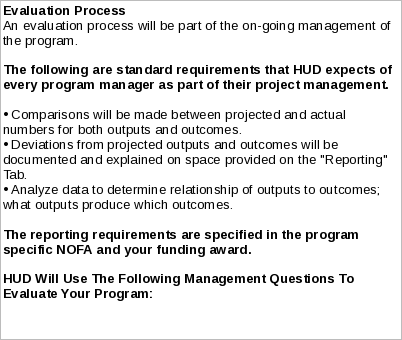
|
|||||||
| Response to Management Questions | Measure | Answer | |||||
| 1 | How many unemployed persons were employed as a result of the activities undertaken during the award? | Persons | |||||
| 2 | How persons are you serving (unduplicated count)? | Persons | |||||
| 3 | How many public facilities were constructed? | Facilities | |||||
| 4 | What is the total square footage of constructed public facilities? | Square feet | |||||
| 5 | How many public facilities were rehabilitated? | Facilities | |||||
| 6 | What is the total square footage of rehabilitated public facilities? | Square feet | |||||
| 7 | How many public facilities were renovated? | Facilities | |||||
| 8 | What is the total square footage of renovated public facilities? | Square feet | |||||
| 9 | What is the value of public facilities constructed, rehabilitated or renovated? | Dollars | |||||
| 10 | How many residential buildings were constructed? | Buildings | |||||
| 11 | What is the total square footage of constructed residential buildings? | Square feet | |||||
| 12 | How many residential buildings were rehabilitated? | Buildings | |||||
| 13 | What is the total square footage of rehabilitated residential buildings? | Square feet | |||||
| 14 | How many residential buildings were renovated? | Buildings | |||||
| 15 | What is the total square footage of renovated residential buildings? | Square feet | |||||
| 16 | What is the value of residential buildings constructed, rehabilitated or renovated? | Dollars | |||||
| 17 | How many new businesses or micro-enterprises were created? | Businesses | |||||
| 18 | What is the value (projected earnings) of new businesses or micro-enterprises created? | Dollars | |||||
| 19 | How many jobs were created? (Unduplicated count) | Jobs | |||||
| 20 | How many FTE jobs were obtained as a result of the award? (Unduplicated count) | Jobs | |||||
| 21 | How many part-time jobs were obtained as a result of the award? | Jobs | |||||
| 22 | How many persons entered into career ladder positions as a result of the activities undertaken during this award? | Persons | |||||
| 23 | What is the average value of jobs created based on an annual wage? | Dollars | |||||
| 24 | What is the average value of jobs obtained based on an annual wage? | Dollars | |||||
| 25 | How many households purchased a home? | Households | |||||
| 26 | What is the value of homes purchased? | Dollars | |||||
| 27 | How many educational or job training opportunities were provided? | Opportunities | |||||
| 28 | How many units/projects incorporated energy efficient appliances and/or design that meet at a minimum Energy Star standards? (Unduplicated count) | Units | |||||
| 29 | How many units/projects/buildings met Green Development standards? (Unduplicated count) | Units | |||||
| 30 | How many new housing units met universal design standards? (Unduplicated count) | Units | |||||
| 31 | How many new housing units met visitability standards? (Unduplicated count) | Units | |||||
| 32 | How many public facilities met universal design standards? (Unduplicated count) | Facilities | |||||
| 33 | How many public facilities met visitability standards? (Unduplicated count) | Facilities | |||||
| 34 | How many rehabilitated housing units met universal design standards? (Unduplicated count) | Units | |||||
| 35 | How many rehabilitated housing units met visitability standards? (Unduplicated count) | Units | |||||
| 36 | How many rehabilitated public facilities met universal design standards? (Unduplicated count) | Facilities | |||||
| 37 | How many rehabilitated public facilities met visitability standards? (Unduplicated count) | Facilities | |||||
| 38 | Of the total number of affordable housing units constructed or rehabilitated, how many were constructed or rehabilitated to national, state or local green rating systems? | Units | |||||
| 39 | How many low-income persons were employed as a result of the activities undertaken during the award? | Persons | |||||
| 40 | How many persons were able to obtain employment as a result of improved access to transportation? | Persons | |||||
| 41 | How many persons were able to receive health care services due to improved access as a result of activities undertaken during this award? | Persons | |||||
| If you are collecting client level data, identify the number of persons receiving services: | |||||||
| 42 | How many persons receiving services are under the age of 6? | Persons | |||||
| 43 | How many persons receiving services are ages 6-17? | Persons | |||||
| 44 | How many persons receiving services are ages 18-30? | Persons | |||||
| 45 | How many persons receiving services are ages 31-50? | Persons | |||||
| 46 | How many persons receiving services are ages 51-61? | Persons | |||||
| 47 | How many persons receiving services are age 62 and older? | Persons | |||||
| end | |||||||

|
|||||||
| ALABAMA | |||||||
| ALASKA | |||||||
| AMERICAN SAMOA | |||||||
| ARIZONA | |||||||
| ARKANSAS | |||||||
| CALIFORNIA | |||||||
| COLORADO | |||||||
| CONNECTICUT | |||||||
| DELAWARE | |||||||
| DISTRICT OF COLUMBIA | |||||||
| FEDERATED STATES OF MICRONESIA | |||||||
| FLORIDA | |||||||
| GEORGIA | |||||||
| GUAM | |||||||
| HAWAII | |||||||
| IDAHO | |||||||
| ILLINOIS | |||||||
| INDIANA | |||||||
| IOWA | |||||||
| KANSAS | |||||||
| KENTUCKY | |||||||
| LOUISIANA | |||||||
| MAINE | |||||||
| MARSHALL ISLANDS | |||||||
| MARYLAND | |||||||
| MASSACHUSETTS | |||||||
| MICHIGAN | |||||||
| MINNESOTA | |||||||
| MISSISSIPPI | |||||||
| MISSOURI | |||||||
| MONTANA | |||||||
| NEBRASKA | |||||||
| NEVADA | |||||||
| NEW HAMPSHIRE | |||||||
| NEW JERSEY | |||||||
| NEW MEXICO | |||||||
| NEW YORK | |||||||
| NORTH CAROLINA | |||||||
| NORTH DAKOTA | |||||||
| NORTHERN MARIANA ISLANDS | |||||||
| OHIO | |||||||
| OKLAHOMA | |||||||
| OREGON | |||||||
| PALAU | |||||||
| PENNSYLVANIA | |||||||
| PUERTO RICO | |||||||
| RHODE ISLAND | |||||||
| SOUTH CAROLINA | |||||||
| SOUTH DAKOTA | |||||||
| TENNESSEE | |||||||
| TEXAS | |||||||
| UTAH | |||||||
| VERMONT | |||||||
| VIRGIN ISLANDS | |||||||
| VIRGINIA | |||||||
| WASHINGTON | |||||||
| WEST VIRGINIA | |||||||
| WISCONSIN | |||||||
| WYOMING | |||||||

| File Type | application/vnd.ms-excel |
| Author | owner |
| Last Modified By | Roberta L. Youmans |
| File Modified | 2010-08-25 |
| File Created | 2005-11-22 |
© 2026 OMB.report | Privacy Policy